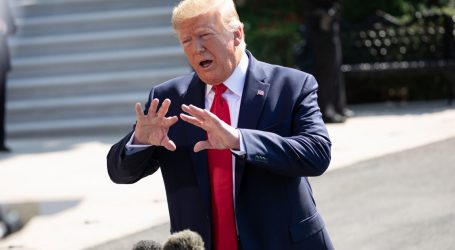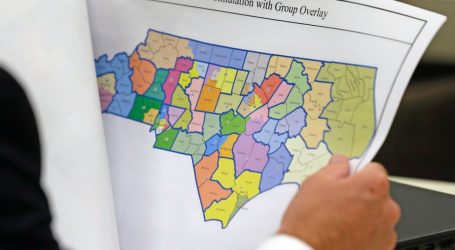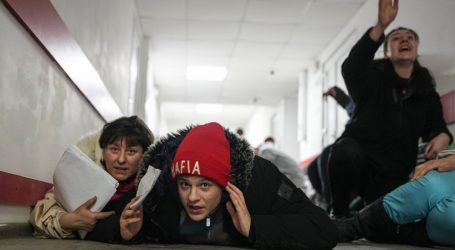How the 2010s Brought Back Strikes, School Walkouts, and Social Movements
Occupy Wall Street protesters wave signs and banners outside the Park Avenue home of JP Morgan Chase CEO Jamie Dimon in October 2011.Andrew Burton/AP
With economic inequality at the highest levels in decades, the climate in crisis, and a political system often unable to address popular demands or even elect the people’s choice, the last decade was shaped by the resurgence of social movements. From the 2011 occupation of the Wisconsin Capitol over collective bargaining rights to 2019’s Puerto Rico protests that pushed out ex-governor Ricardo Rosselló, more and more Americans took their politics to the streets in the 2010s.
Labor journalist Sarah Jaffe, author of Necessary Trouble: Americans in Revolt, traces the explosion in movement politics to the financial crisis of 2008. People who lost their jobs and retirement savings in the crash still haven’t recovered. And though the unemployment rate has fallen over the decade, lower-paying service sector work has supplanted many of the middle-income jobs lost in the recession.
“The 2008 financial crisis killed capitalist realism,” Jaffe says. “We can’t quite imagine what comes next, but we know that the thing that we have been living under doesn’t work anymore. And so we’ve seen movement after movement that is some form of reaction to that.”
“Do you want to get rid of that inequality, or do you just want to regain your place in it?”The economic crisis worsened inequalities along racial lines. Black and Latino communities, who were targeted with subprime loans, were hit particularly hard by the foreclosure crisis. At the same time, the crash sparked a right-wing backlash against both bailouts and newly elected president Barack Obama. Tea Party activists framed their cause as economic. But at its heart was a make-America-great-again philosophy of who deserved government services, political power, homeownership, and the opportunity to build wealth.
“The question of what you do about that inequality, I think, is the one that drives people to the left or the right,” Jaffe said. “Do you want to get rid of that inequality, or do you just want to regain your place in it?”
These are some of the movements for justice that shaped the 2010s.
Occupy Wall Street
In 2008, Congress bailed out the financial institutions that made millions homeless by selling and bundling subprime mortgage loans that the lenders knew would fail. Three years later, widespread fury with big banks crystallized into Occupy Wall Street, a movement that started in New York’s Zuccotti Park and quickly spread across the country. Protesters set up encampments that lasted months, taking a stand against policies benefiting the richest one percent at the expense of everyone else.
In cities like Minneapolis and Atlanta, foreclosed homeowners organizing with Occupy refused to leave their homes, demanding negotiations from the banks that drove the crash. Occupy’s influence lives on: taxing the extremely wealthy to reduce inequality is a central tenet of both Bernie Sanders’ and Elizabeth Warren’s Democratic primary campaigns.
While the top 0.1% of American households sit on massive amounts of wealth, millions of families are living paycheck to paycheck.
It’s time for the wealthiest families to pitch in so everyone can succeed. https://t.co/Eu2KWJ2IwV
— Elizabeth Warren (@ewarren) October 21, 2019
At the end of the day, the 1 percent may have enormous wealth and power. But they are just the 1 percent. When the 99 percent stand together, we can transform society.
— Bernie Sanders (@BernieSanders) August 11, 2019
The Movement For Black Lives
Police violence against black and brown people is as old as policing. Protests against this violence aren’t new—but this decade, those protests took on new force. Video footage of fatal police encounters gave us an alternative to the inevitable police self-defense narrative that long dominated media reports.
With cell phones and social media, bystanders documented and shared deadly police encounters in real time rather than in the footnotes of a buried police report. Through their eyes, we collectively witnessed Michael Brown’s body lying in the street in Ferguson, Eric Garner gasping for breath as a New York City police officer choked him to death, Tamir Rice collapsing after a police officer shot him at a playground in Cleveland, Sandra Bland’s violent arrest after being pulled over in Texas, Philando Castile dying in his car in Minnesota, and too many more to name.
The protests over their deaths were met in city after city with a militarized police response, galvanizing still more people into the streets. When police officers evaded charges or were acquitted, the protests began again. As Mother Jones reporter Jamilah King wrote in 2017:
Stockley’s acquittal may have been the match that lit the fuse in St. Louis, but the protests were the result of anger at a history of indignities suffered by black communities over generations. In 2014, after 18-year-old Michael Brown was shot and killed by ex-officer Darren Wilson in neighboring Ferguson and that city exploded in righteous anger, the U.S. Department of Justice tallied the Ferguson police department’s interactions with the local, majority black community over several years. One finding was that Ferguson generated the bulk of its revenue from municipal fines that unfairly targeted black residents.
But the most profound indignity of all has been the pace at which black people die at the hands of the police, and how seldom anyone is held accountable for those deaths. An investigation by the Guardian in 2015 found that young black men are nine times more likely to be killed by police than Americans of other races. But the Guardian also noted that convictions in such cases are rare.
Cities around the nation react to #Ferguson pic.twitter.com/QfpfUZs2wh
— Logan Rhoades (@LoganRhoades) November 25, 2014
Standing Rock
The fight against oil pipelines reached new heights in 2016, when thousands of people joined a ten-month encampment on the Standing Rock Sioux reservation in North Dakota, protesting a proposed oil pipeline over concerns around toxic contamination. (Earlier that year, another pipeline leaked over 200,000 gallons of oil in the area; in 2019, the same pipeline leaked another 380,000 gallons, contaminating a North Dakota wetland.) It was the largest Native American occupation since Wounded Knee in 1973, and laid the groundwork for a new phase of mass climate action.
The pipeline fight was about protecting both the environment and tribal sovereignty. As we reported in 2017:
Many at Standing Rock saw the threat of environmental catastrophe as inextricable from racial injustice. An early proposal to route the Dakota Access Pipeline through Bismarck, 45 miles north of the reservation, was rejected by the US Army Corps of Engineers because of concerns that it could harm the municipal water supply. (Bismarck’s population is 92 percent white.) “But it’s okay if it poisons Natives’ water, right?” said Chanse Adams-Zavalla, a 22-year-old who grew up on the Maidu reservation just north of Santa Barbara, California. He wore a camouflage backpack that had “Fuck Off” written on it and a matching camo cap that said “Smile More.” In May 2015, the coastline near his reservation was ravaged by the rupture of an oil pipeline. “It’s disgusting what happened to my people, bro, and we’re still being treated that way,” he said.
As thousands of people faced off with police in North Dakota, protesters across the country demanded that their communities help cut off the Dakota Access Pipeline’s funding, filling city halls to demand divestment from the pipeline, which was backed by familiar villain Wells Fargo.
At Bayou Bridge in rural Louisiana, activists physically obstructed construction at the tail end of the Dakota Access Pipeline by locking themselves to equipment, dangling from trees and kayaking to worksites. It was the first environmental direct action campaign in the state. In Virginia’s Appalachian Mountains, protesters have been blocking a pipeline’s path for more than a year.
One of the most powerful photos of the year, from Standing Rock Indian Reservation by Ryan Redhawk. https://t.co/685buo2bh0 pic.twitter.com/X6fQYxwuto
— Steve Silberman (@stevesilberman) November 7, 2016
The Women’s March and #MeToo
The day after the inauguration of a president who bragged about sexually assaulting women, millions of people filled the streets across the country for a Women’s March. The Washington Post wrote that it was “likely the largest single-day demonstration in recorded U.S. history,” estimating that 4 million people—about 1.3 percent of the U.S. population—participated.
The New York Times identified 201 men ousted from their jobs in the year after the #MeToo movement took off—and found that almost half their replacements were women.The same year, anger over pervasive sexual violence boiled over after the New York Times and the New Yorker reported decades of sexual harassment allegations against Hollywood producer Harvey Weinstein. Thousands of survivors shared their own experiences of sexual violence on social media with the viral hashtag #MeToo, a phrase first used by activist Tarana Burke to encourage sexual violence survivors to share their stories.
As more survivors named powerful men who had sexually harassed or assaulted them, some of those men actually started to face consequences. The New York Times identified 201 men who were ousted from their jobs in the year after the #MeToo movement took off—and found that almost half their replacements were women.
We broke the record for largest gathering in Texas history. #WomensMarch #WomensMarchOnAustin #WomensMarchATX pic.twitter.com/25TM2AdtYe
— Austin NOW (@AustinTX_NOW) January 21, 2017
the aerials out of chicago #womensmarch are something else pic.twitter.com/ucvwtVzYM5
— Christina Manduley (@cmanduley) January 21, 2017
Teachers’ Strikes
The Chicago Teachers Union’s seven-day 2012 strike set the stage for a national revitalization of teachers’ labor organizing. Jane McAlevey, author of Raising Expectations (and Raising Hell), told Mother Jones in September:
Chicago sets an example. They have this extraordinary strike in 2012. It takes everyone’s breath away in the most exciting way…despite a multimillion-dollar campaign to give teachers a black eye and blame them for the underfunding and defunding of public education, what people saw and took their breath away was: “Hey, wait a minute, the community in Chicago rallied around those teachers. They didn’t blame them. They stood with them.” And when workers in the rest of the country, especially teachers, saw that parents sided with teachers, that to me is the beginning of the spark.
The Chicago strike, which won teachers a 16 percent raise over four years and reduced emphasis on test scores in their evaluations, showed teachers around the country what was possible. By the end of the decade, the tactics used in Chicago had surged nationwide. The West Virginia teachers’ strike of February-March 2018 was soon followed by statewide strikes in Arizona, Oklahoma, Kentucky, Colorado and North Carolina—and by big wins. West Virginia teachers won a five percent pay raise and a commission to deal with insurance costs. In 2019, Los Angeles teachers won more counselors, nurses and librarians for their students. In Kentucky, Gov. Matt Bevin’s battles with the teachers’ union may have cost him reelection.
According to the Bureau of Labor Statistics, more workers took part in a strike last year than in any year since 1986. Teachers topped the list.
Red-state revolt continues: Teachers strike in Oklahoma and protest in Kentucky https://t.co/XxwCg4JomT pic.twitter.com/t8vWZ2Hxre
— Los Angeles Times (@latimes) April 3, 2018
The Youth Climate Movement
The 2010s saw the beginning of a youth-led climate movement that was bolder—and more contagious—than in any previous generation. Inspired by Swedish teenager Greta Thunberg’s school strike and using a lens of generational justice, U.S. teenagers started organizing their own school walkouts. Youth with the Sunrise Movement have staged confrontations in the offices of prominent Democrats like House Majority Leader Nancy Pelosi and Sen. Dianne Feinstein to demand aggressive climate action.
This is how @SenFeinstein reacted to children asking her to support the #GreenNewDeal resolution — with smugness + disrespect.
This is a fight for our generation’s survival. Her reaction is why young people desperately want new leadership in Congress. pic.twitter.com/0zAkaxruMI
— Sunrise Movement 🌅 (@sunrisemvmt) February 22, 2019
As Rebecca Leber reported earlier this month:
Young people have a good track record of challenging the status quo. But more importantly, the threat of climate change feels particularly acute to young people—without immediate action, the environment will profoundly change in their lifetimes.
…
Since those early days, the group has pulled off a handful of successful escalations—protests, school strikes, and confrontations with top Democrats whose climate policies they deem too timid. After each of these actions, Sunrise leaders have swooped in to set up recruitment drives and more trainings for new members.
And in part due to those efforts, the percentage of voters who say that the climate is their top priority has more than doubled since 2016.
Photos from yesterday youth-led climate strike in Washington DC. Fotografía de @ConradoMuluc #ClimateStrike #ClimateStrikeDC #savetheplanet #latinx #fotografia pic.twitter.com/7gDrnAwwpm
— Conrado Muluc (@ConradoMuluc) September 21, 2019
The estimated number in New York is over 250’000! They closed the park because there were too many people… I’m speaking soon at Battery Park. #ClimateStrike pic.twitter.com/YOD80SxHaa
— Greta Thunberg (@GretaThunberg) September 20, 2019
Jaffe says the trend of social movements isn’t going anywhere. “Unless and until people start feeling improvements in their actual everyday lives, things are going to get more volatile, they’re going to get more messy, they’re going to get more unstable,” she says.
But the sheer number of youth striking for the climate gives Jaffe hope. One in seven teenagers in the U.S. has participated in a climate walkout, according to a Washington Post/Kaiser Family Foundation poll last summer. “What does that mean when those kids get into the workplace?” she asks. “When I’m having a bad day, I try to remind myself of that.”





